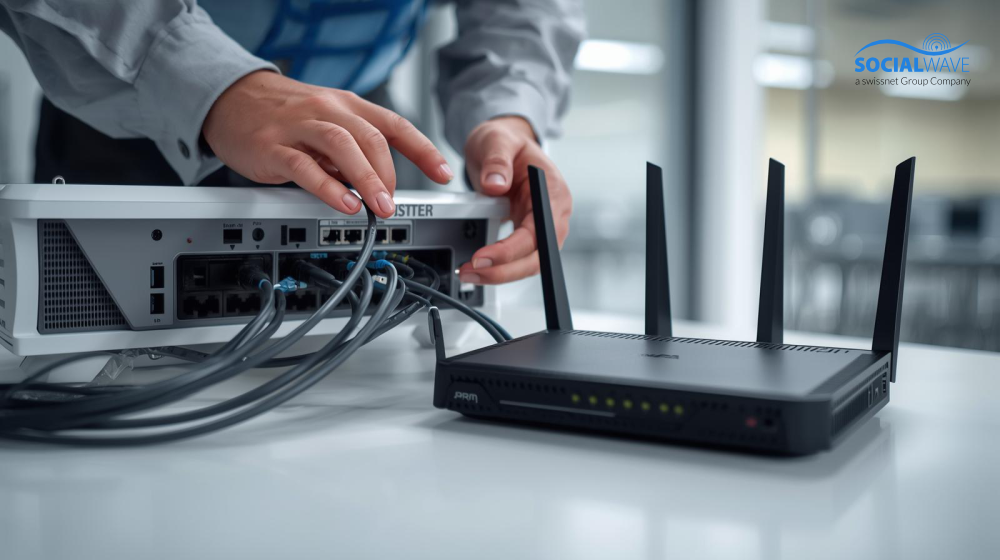Misunderstandings about WiFi: We'll explain it to you!

Thanks to Corona crisis One thing was made clear to us in the past year: the importance of a functioning WLAN router in the home. The function of a WLAN connection has existed since 1990. In 2020, decreed 96% of German households via Internet access. It's hard to imagine life without a WiFi network these days. Even a visit to a café, restaurant or a trip on the train is not complete without using public WLAN. Many people are skeptical about this development. There are still numerous misunderstandings about WLAN. In this blog post, we would like to uncover them for you.
Facts about WiFi
You've probably asked yourself the question of what the abbreviation WLAN actually stands for. WLAN stands for Wireless local area network and translates as “wireless, local area network.” Devices can be connected to the Internet via WLAN. No cable is required for this. The word WLAN is a generic term for all wireless and local data networks. As we move on, we will first introduce you to some basic facts about WiFi.
How it works
A broadband connection (e.g. DSL or VDSL) and a WLAN router are the most important requirements for a wireless network. As soon as the router's WLAN function is activated, it constantly transmits at a frequency between 2400 and 5725 MHz (megahertz). Any WLAN-enabled device, such as smartphones or tablets, can be connected to the router.
velocity
In 1997, the first standard for wireless Internet connectivity (IEEE 802.11) with a transfer rate of 2 Mbps. In recent years, this has been constantly expanded and improved. Nowadays, with the standard IEEE 802.11ax (2020) enables speeds of up to 1300 Mbps.
range
A WLAN router should be placed as high up in a room as possible in order to make optimal use of WLAN reception. In addition, the router should be vacant, in a centrally located room. The position of the router is crucial for good WLAN reception, as it has omnidirectional antennas. The WLAN signal is spherical in all directions, so to speak. Here, the router is in the middle of the sphere. There should be few obstacles between the router and other WiFi devices. The biggest obstacles to the WLAN signal are metal and water-containing objects such as radiators or refrigerators. It should also be noted that the router is located away from other radio transmitters such as microwaves, baby monitors or Bluetooth devices.
surety
To ensure the security of the home wireless network, the signal should be encrypted. This prevents strangers from using Internet access and accessing personal data. It is therefore important that network authentication and encryption are always active!

Five misconceptions about WiFi
1. WiFi radiation is harmful to health
Wrong! First of all, it is important to explain how strong these radiations actually are. Depending on the frequency range, WLAN connections transport between 100 milliwatts and one watt of energy (radiation output). Radiation power measures how much a (usually electronic) device radiates in its environment. This means that the farther away you are from the radiation source, the weaker the radiation becomes. The same applies to the load. As a comparison, an average energy-saving lamp consumes between five and 25 watts. For light bulbs, it is even more, namely between 15 and 300 watts.
Electrical appliances with WLAN reception do not exceed legal limits. This refers to the Federal Office for Radiation Protection (BfS) on the Specific absorption rate (SAR). This indicates how much radiation power human tissue absorbs. According to the authorities, 0.08 watts per kilogram of body weight are considered harmless. This value is slightly lower than the maximum radiated power of WLAN. In addition, the entire body is rarely irradiated by WLAN. Even at a distance of one meter, the load values fall by 80 percent.
But, WLAN radiation causes electrosmog (electronic radiation exposure). This is caused by the large number of electronic devices. Radiations of this type can cause negative effects in humans, e.g. deconcentration, headaches or tension. During the current peak phase of working from home, some of you will probably have experienced some negative effects yourself.A few simple tips from us for those who, despite everything, do not want to unnecessarily burden their body with WiFi radiation:
- Maintain the minimum distances recommended by the manufacturer.
- Try to place the wireless router as far away from places where you spend a long time (e.g. bed or work).
- If possible, avoid WiFi and use cable connections.
- With a timer or router settings, you can turn off the WLAN when you don't need it — at night, for example.
2. All WiFi routers are the same
Wrong! Nowadays, a working WiFi router is an essential part, not only in homes but also in businesses. Although the various WLAN routers have external similarities, they differ significantly in their quality. On the one hand, there are differences in the used technology, which emits the WLAN signal. This has a direct effect on the stability of the signal. On the other hand, every WLAN router has a small computer. From whose computing power It depends on how many users the router can serve at the same time. It is therefore important that special and powerful hardware that has sufficient performance is used in the public or commercial sector. In this way, hundreds or even thousands of users can easily use the WLAN.


3. WiFi can be easily shared with everyone
In summer 2017, the Telemedia Act was amended. It gave the impression that the Liability for Interference (“Liability for WLAN networks”) has been abolished. This would mean that anyone can openly offer their own WLAN without having to be liable if foreign users do something illegal about it. In this way, the WLAN network would represent a lawless space in which anyone can do what they want. A possible prosecution would not take place. However, this view is the legislative amendment wrongly! Until summer 2017, lawyers were able to send paid warnings. This was the case, for example, when the upload of copyrighted material (e.g. music or films) could be proven. Conversely, for providers of open WLAN, this meant that costs had to be expected at all times. Legislators prevented this procedure in June 2017. But this does not mean that you are generally no longer liable if something illegal is disseminated via your own WLAN connection. Now the procedure is as follows: The corresponding law firm simply has to follow the regular route. This usually amounts to legal proceedings. Accordingly, for providers of public WLAN networks, the 2017 Act means that a simple notice does not release them from liability. At all times, the subscriber is the only person to be identified, who is also the first point of contact for the police and public prosecutor's office. In the worst case scenario, these providers must hold themselves responsible for breaches made by others. In addition, a claim was made to Network blocks introduced. This means that a subscriber can be required to block certain websites. The aim is to prevent misuse by external users.
4. Mobile Internet replaces WLAN
For 15 years, the mobile Internet for smartphones using the “UMTS” standard has been increasingly popular. At the same time, the first voices were raised to doubt the need for WLAN. Nowadays, mobile communications and WLAN are two parallel existing standards. With both, the Internet can be used wirelessly. Mobile communications are available everywhere and it is possible to always be online even while on the go. However, the reality is different. The speed depends heavily on the region and the number of concurrent users. The problem here is that the available capacity (bandwidth) must always be shared with all other users. This results in strong fluctuations. It is therefore possible that there is only a very low speed in certain regions. The topic of data volume is also relevant. As a result of streaming music or movies via Spotify or Netflix, for example, the existing volume of data is quickly exhausted. Since in the future, many applications will no longer store data on smartphones but on the Internet, the need for data will increase sharply. wronglythat WLAN is being replaced by mobile Internet. Professional WiFi networks offer your users high bandwidth and there's no need to worry about streaming, browsing, or downloading. Your own data volume is never used up.
5. WiFi for guests is an unnecessary cost
Wrong! First of all, a professional WLAN infrastructure represents more costs. These are used for one-time set-up and operation. WLAN hotspots are now not just a service for guests and customers, but an important advertising tool for your company. For example, guests at a restaurant can already read the menu on the display during the login process. The guest will definitely take advantage of them.
It is also possible to integrate a wide variety of social media profiles. In this way, potential followers are generated and it is possible to provide feedback. Of course, there are many other ways to use the Guest WiFi Your company or service to support.

conclusion
Setting up a professional WiFi network not only includes a certain level of convenience for your guests, customers or patients, but you also have the option to use various marketing tools. The focus here is on maintaining a lasting relationship with your guests, customers or patients. With the help of this blog post, we were able to show you numerous advantages of a WLAN network and also eliminate some misunderstandings regarding this topic. Take advantage of this opportunity and have a professional WLAN network set up for your company or service! Especially during the ongoing corona pandemic, this investment will pay off. In this way, the relationship with your guests, customers or patients will remain active. With our WLAN marketing package, your customers/patients/guests advertise you, are happy and recommend you to others.








.svg)

.svg)
.svg)



